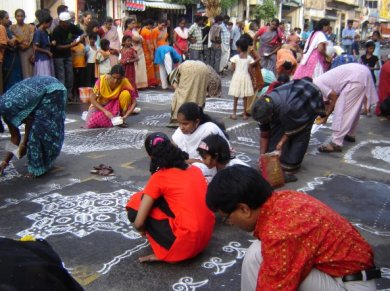
|  |

|  |
Reflections on beauty as an element of aesthetics - Shanta Serbjeet Singh e-mail: shanta.serbjeetsingh@gmail.com May 25, 2015 Some months ago I was in Chennai. I was heading for a cultural program in a city auditorium. Suddenly, the car that I was travelling in braked, the busy traffic ahead of us slowed down. Then it started to re-align, following the directions of the young man standing in the middle of road, waving his hands, directing the traffic to the left and right of the central obstruction. And what could that be, I wondered, since I could see no truck or bus or an identifiable road block. But soon I noticed what it was that the young man was 'protecting'-- a huge kolam being drawn in the middle of the road, its abstract circular design being deftly filled in with rice flour and organic colours. A group of women were bent over the pattern, saris tucked knee-high, hands busy giving final touches to the design. A narrow swathe of tarmaced road on either side was being left free, to let people to go about their daily business.  But for those involved in this ritual of making art on a busy, city road, this was what the business of life was all about. It was an expression of an individual's inner need to make art, a process that begins alone but becomes true for all those who are engaged in it, even for those of us who were just looking. Suddenly it was a common endeavour, for an auspicious purpose, to mark the annual festival that night of the Kapaleeswarar temple, towering over the scene at a stone's throw distance, offering a tryst with both beauty and art as we all chose to perceive it. For me it was a validation of the classical core of Indian aesthetics, satyam, shivam, sundaram, that which is truthful, that which is auspicious and that which is beautiful. But does this concept actually work in this age of rootlessness and unstandandarised notions of what is aesthetic and satisfying? Is beauty, for instance, still essential to art? Not at all and any number of great artists contest this notion. At a conference in which I participated some time ago, entitled "The end of beauty, the promise of art" the gathering of scholars and practitioners of art were all engaged in this concept. Questions like what is the place and purpose of art in the modern world and what role it may play in society at large and in society's material, emotional and spiritual life. Their brief was to posit this theme against both theoretical reflections on aesthetics, practices of artistic production and art education, as well as between European and Indian aesthetic traditions, the idea being to bring into greater focus the twin traditions of Indian aesthetics and Western discussions about the future of art and the role of beauty. To start with, it is generally agreed that that which is pleasing in appearance may be said to have an aesthetical value. In Western studies, by the 18th century, it was generally accepted that there was uniqueness in aesthetic experience as well as in artistic creation. Equally, that there was a vital role for aesthetics in the larger moral concerns of mankind. This has not been surrendered even in the most tempestuous growth of modern art. Kant showed how morality has unconditional value while aesthetics has independent value. Alexander Baumgarten's Reflections on Poetry, the work that introduced the term "aesthetics" in 1735 and postulated the thesis that aesthetic judgments are completely distinct from moral judgments, would not receive its modern formulation until Kant's Critique of Judgment (1790), after Hume's death in 1776. So Hume's aesthetics occupies a pivotal niche between the appearance of fine art theory and Kant's defense of an independent aesthetic judgment in the Critique of Judgment - a defense clearly influenced by Kant's reading of Hume's essays and An Enquiry Concerning the Principles of Morals. In the Indian tradition of aesthetics, beauty, aesthetics and morality are inextricably intertwined. Here beauty seems a merely sensory pleasure, and the seeker of truth is never allowed to forget it. Rather he emphasizes beauty's status as no more than a cognitive pleasure. And yet, Indian aesthetics, swears by the interdependence of beauty, aesthetics and morality. It believes that the individual is concerned with the true nature of things, loves the world of truth as distinct from the realm of untruth and hence has an inherent love of symmetry, of order, pattern and beauty and that all of them satisfy the mind deeply. According to Indian aesthetics, while truth attracts our admiration, awe and wonder, beauty evokes a sense of inner delight. All things that 'satisfy' are embodied in art. But what is it that makes anything look beautiful? Philosophically, we may say that the proportion in which the Infinite, or the Absolute, as the highest universal, is visualized in any particular thing will decide the extent of beauty which that thing evokes. It is the universality involved in the particular that is the source of beauty and the sense of perception. In the perception of beauty, the processes involved are the perceiving mind, the act of perception and the object itself. The question arises, whether the object can be considered to be beautiful even if there is no one to perceive it. We may perhaps, in a way, concede that beauty and perfection do not require somebody to know them, since the flower and the moon and the charming face of a child can remain beautiful even if there is no one to see them. Our commonsense understanding would like to assert that this is true, but is this really true? Does the flower know that it is beautiful? Is the moon beautiful to itself? That is, does beauty really exist apart from the beautiful object? Here we seem to be in a doubtful position, and it does not look that, in the end, beauty can justify itself apart from the process of its being perceived. If being perceived is what gives beauty to an object, it would mean that beauty is in the perceiving mind rather than in the object. It has been well said that beauty is in the eye of the beholder. But here, again, is a question: can the mind perceive beauty if there is nothing to be perceived at all? Does the mind know that it is the source of beauty even if it has nothing to conceive or think of? It is the mind which perceived something as highly desirable and hence beautiful. But then comes the day when the nature of the mind changes and the same object no longer appears beautiful. It seems ordinary, even commonplace. You think you have been deceived. But no one has deceived you and now that the perception has changed, it is clear that beauty never existed in the particular object, to begin with. It is just subjective, never objective. It is only when this realization dawns on one, it is only when you finally realize that there is no such thing as beauty or ugliness, good or bad, except as the mind perceives it, that the true nature of beauty can be understood. And it is only at this stage that beauty's relationship with truth be understood. Thus, it would appear that beauty is entirely relative to the conditions prevailing in a given form of interaction between the subject and the object. Beauty, then, would belong neither to the subject nor to the object. It is not something existing by itself. It is a state of consciousness that suddenly erupts in-between the subject and the object, but not belonging either to the subject or the object, a transcendent inclusiveness which oversteps the limitations of the subject and the object and brings them into a state of harmony and mutually cooperative association to make good what each lacks but can be found in the other, so that the union between the two characters engenders a consciousness of self-transcendence, which is both enduring beauty and great grandeur.  Shanta Serbjeet Singh, for twenty-five years, columnist, critic and media analyst for The Hindustan Times, The Economic Times and The Times of India, is the recipient of the Lifetime Achievement Award of the Sangeet Natak Akademi and Delhi Govt.'s Sahitya Kala Parishad for her contribution to the field of culture. She just finished her term as Vice Chairman of the SNA, is the founder-secretary of the World Culture Forum and continues as Chair of the UNESCO created NGO APPAN (The Asia-Pacific Performing Arts Network), a position to which she was appointed in 2001. Singh has authored several well-known publications such as 'Indian Dance: The Ultimate Metaphor' (published by Ravi Kumar (Paris), 'The 50th Milestone: A Feminine Critique' (Sterling Publishers, to mark India's fiftieth anniversary of Independence), 'Nanak, The Guru' (Oxford University Press) and 'America and You' (22 editions). Post your comments Pl provide your name and email id along with your comment. All appropriate comments posted with name and email id in the blog will also be featured in the site. |